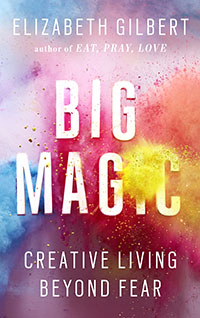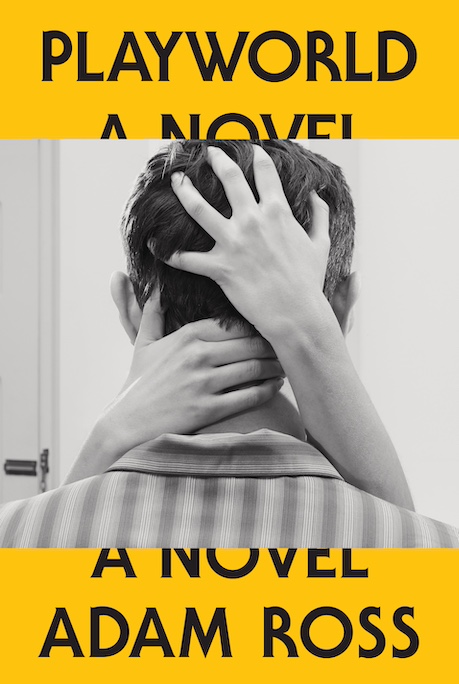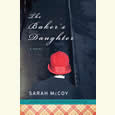The Way and the Truth of Creative Living
A Chapter 16 writer takes Elizabeth Gilbert’s new writing guide, Big Magic, out for a spin
Years ago, on the heels of the Eat Pray Love craze, my mother—who’d thoroughly enjoyed that blockbuster book—urged me to watch a TED Talk by its author, Elizabeth Gilbert. In it Gilbert said some wonderful things, Mom told me; though I hadn’t read Eat Pray Love, she just knew I’d find the TED Talk interesting. I promised her I’d watch the video, and then, despite reasonably good intentions, I never did.
 Time passed, and others raved to me about that video. I always nodded thoughtfully, said, Yes, yes, I need to watch that. Always those same good intentions. But to YouTube I did not hasten. Then Gilbert’s new book, Big Magic: Creative Living Beyond Fear—an inspirational work geared toward those who want to write but applicable to creative practice in general—entered my life. I knew it would be a big hit, considering the tremendous impact Eat Pray Love had on readers. What I didn’t predict was how big a hit it would be with me, wary of the self-help enterprise as I am. But I emerged if not a born-again Gilbert acolyte, then at least a new admirer.
Time passed, and others raved to me about that video. I always nodded thoughtfully, said, Yes, yes, I need to watch that. Always those same good intentions. But to YouTube I did not hasten. Then Gilbert’s new book, Big Magic: Creative Living Beyond Fear—an inspirational work geared toward those who want to write but applicable to creative practice in general—entered my life. I knew it would be a big hit, considering the tremendous impact Eat Pray Love had on readers. What I didn’t predict was how big a hit it would be with me, wary of the self-help enterprise as I am. But I emerged if not a born-again Gilbert acolyte, then at least a new admirer.
Big Magic is arranged in brief sections, more like vignettes than chapters per se. In each Gilbert develops a point or shares an illustrative anecdote, which makes the book ideal for browsing, if that’s your thing. (Some redundancy creeps in, yes, but not as much as you might suspect if you are, like me, innately wary of this genre.) Among other ideas, she asserts a firm belief that curiosity, not passion (that dead horse of creativity talk), is “the way and the truth of creative living,” that great ideas are a “disembodied, energetic life-form” waiting to be made manifest “through collaboration with a human partner,” that quitting your day job to pursue a creative life for financial return is a terrible plan, and that possessing a creative mind is akin to having a border collie for a pet:
It needs to work, or else it will cause you an outrageous amount of trouble. Give your mind a job to do, or else it will find a job to do, and you might not like the job it invents (eating the couch, digging a hole through the living room floor, biting the mailman, etc.). It has taken me years to learn this, but it does seem to be the case that if I am not actively creating something, then I am probably actively destroying something (myself, a relationship, or my own peace of mind).
Kind of irresistible, right? Even that New-Agey bit about free-floating ideas—which “don’t have a material body, but they do have consciousness,” according to Gilbert—stood the test of my skeptical eye. That’s in part because it’s a fun (if wacky) way to think about where we get our ideas, but also because she illustrates this notion with a gem of an anecdote about Ann Patchett, in which she claims that the germ of the idea for what became Patchett’s novel State of Wonder passed between them, bacterium-like, though a kiss. Gilbert knows she’s plunging head-first into the mystical Jell-O here and is seemingly unfazed by the sour grapes anyone might spit back as a result.
 Later on in the book she even disabuses readers of the notion that creative work is some kind of higher calling: “You would be hard-pressed to identify a job that is not objectively more valuable to society than mine,” she allows. But then watch how, in the next breath, she spins such pragmatism in creativity’s favor: “Pure creativity is magnificent expressly because it is the opposite of everything else in life that’s essential or inescapable (food, shelter, medicine, rule of law, social order, community and familial responsibility, sickness, loss, death, taxes, etc.).” Creativity, she argues, is something we need deeply, the key to balance, the great release valve. Her message is always one of encouragement, her tone at once no-nonsense and uplifting.
Later on in the book she even disabuses readers of the notion that creative work is some kind of higher calling: “You would be hard-pressed to identify a job that is not objectively more valuable to society than mine,” she allows. But then watch how, in the next breath, she spins such pragmatism in creativity’s favor: “Pure creativity is magnificent expressly because it is the opposite of everything else in life that’s essential or inescapable (food, shelter, medicine, rule of law, social order, community and familial responsibility, sickness, loss, death, taxes, etc.).” Creativity, she argues, is something we need deeply, the key to balance, the great release valve. Her message is always one of encouragement, her tone at once no-nonsense and uplifting.
As I made my way through Big Magic, I underlined and starred passages on nearly every page, pausing occasionally to question why or how these favorite lines managed to come off as not at all corny or platitudinous. These were not always groundbreaking ideas. What Gilbert tells us, other sage writers have sometimes already told us, too, often quite beautifully. Had I officially drunk the Liz-Aid? Or was it…magic? Either way, the book has snuggled up to me, and I to it.
Perfect timing may have something to do with my enthusiasm for Big Magic. The book comes to me at a point when I am ready to think in a fresh way about my own writing habit. For some time I have guzzled the perspective, voiced in various ways by countless successful writers, that writing is difficult, if not torturous; that creation is a long crawl through an often pitch-black tunnel. I found such talk oddly nourishing. My personal struggle was thereby validated; my slow output excused. Writing is freaking hard—everybody says so! I was hardly alone in my toil.
And, yeah, creating is hard work. This is a point Gilbert never denies. She isn’t blowing sunshine, or if she is she’s blowing it in a way that’s also realistic. In Gilbert’s philosophy, writing is equal parts fairy dust and sweat. Her positivity is infectious not just because she’s funny, irreverent, and frank about her own foibles (“my fear and my creativity are basically conjoined twins”), but because steely discipline and determination—stubbornness—have been the mainstays of her creative life.
She warms us up with the Greco-Roman concept that genius is not something we’re born with, or even something we cultivate within, but an external being who chooses to hang out with us, “a sort of house elf, if you will.” But she also lays bare her Puritan work ethic: “If anything, I have come to believe that my genius spends a lot of time waiting around for me—waiting to see if I’m truly serious about this line of work,” she writes. “I work either way, you see—assisted or unassisted—because that is what you must do in order to live a fully creative life. I work steadily, and I always thank the process.” Later, she describes applying this tenacity to the submission process, volleying a rejected story right to another magazine, playing “the game of rejection letters as if it were a great cosmic tennis match.”
Where pragmatism has its place, so does a democratic attitude toward art-making. When a radio interviewerwondered if her book will encourage readers to let loose a flood of bad art into the world, Gilbert said, simply, “I’m a populist.” She isn’t interested in thinking about whether art is bad or good:
I will fall asleep with my face in my dinner plate if someone starts discoursing to me about the academic distinction between true mastery and mere craft. I certainly don’t ever want to confidently announce that this person is destined to become an important artist, while that person should give it up.
How do I know? How does anyone know? It’s all so wildly subjective, and, anyhow, life has surprised me too many times in this realm. On one hand, I’ve known brilliant people who created absolutely nothing from their talents. On the other hand, there are people whom I once arrogantly dismissed who later staggered me with the gravity and beauty of their work. It has all humbled me far beyond the ability to judge anyone’s potential, or to rule anybody out.
If creativity is something you value highly—both in others and as fundamental to your own existence—you should find much to love in Big Magic, whether or not you typically gravitate toward creativity guides. The risk with books of this kind, of course, is that it’s easier and more immediately satisfying to read them than it is to complete tangible creative work. (Is it possible to be creative by proxy?) But Gilbert knows this, too. In the final paragraph she urges her readers in no uncertain terms to “calm down now and get back to work, okay?”
And I will, Liz, I swear. And then, perhaps, I will check out your TED Talks—and that dazzling podcast I keep hearing about, too.
[This article appeared originally on October 14, 2015. It has been updated to reflect new event information.]

Susannah Felts is a writer, editor, and educator in Nashville, as well as co-founder of The Porch Writers’ Collective, Nashville’s nonprofit center for writing. She is the author of This Will Go Down On Your Permanent Record, a novel, and numerous journal and magazine articles.


